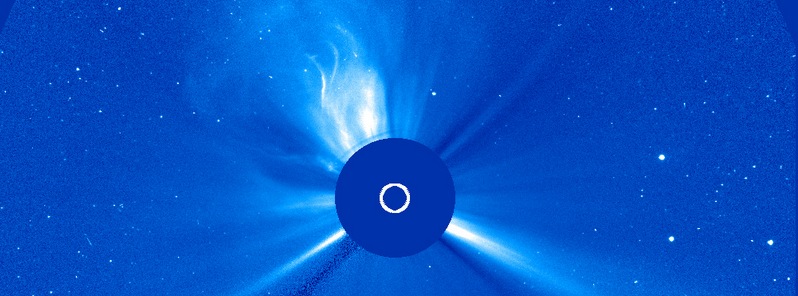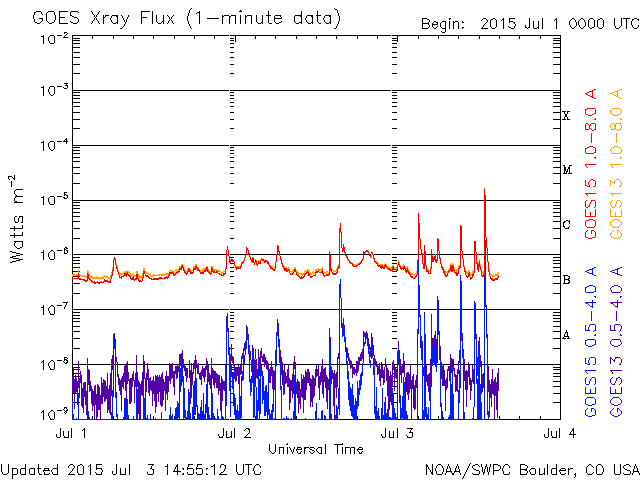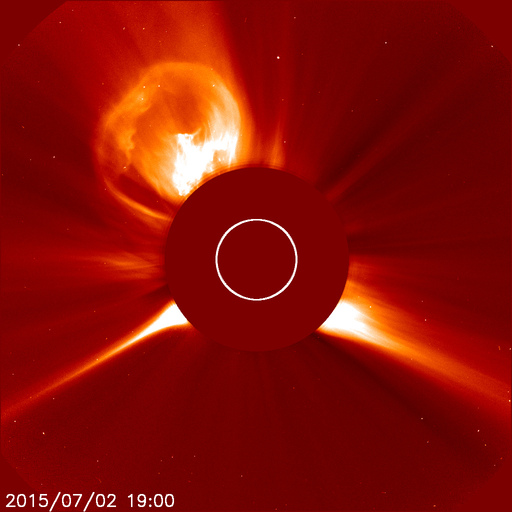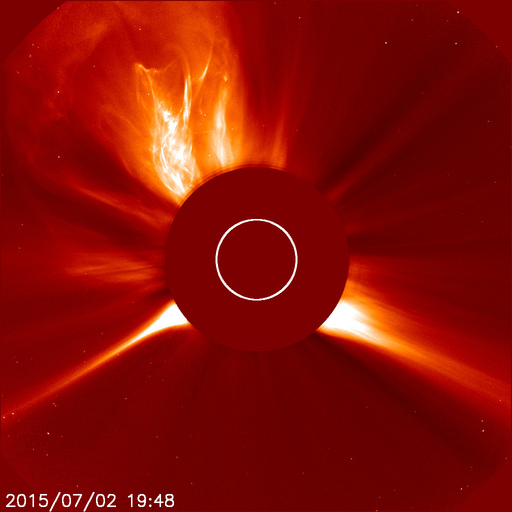Filament eruptions and impulsive M1.5 solar flare, geomagnetic storming expected due to CH HSS

Moderately strong solar flare reaching M1.5 at its peak time erupted at 12:53 UTC on July 3, 2015. The event started at 12:47 and ended at 12:53 UTC.
The source was Region 2378, which rotated into the southwest quadrant yesterday producing innumerous C-class solar flares.
It seems Coronal Mass Ejection (CME) was not produced, and even if it was, it would most likely be directed away from the Sun-Earth line. This will change in the days ahead as the region rotates toward the center of the solar disk and into more geoeffective position.

Additionally, a 17 degree long filament over the far SW quadrant of the Sun, centered near S39W50, became active and disappeared beginning about 04:00 UTC on July 3. Analysis of available imagery indicates an eruption was unlikely and most of the material reabsorbed.
An eruptive prominence from just beyond the northeast limb was observed in SDO/AIA 304 imagery beginning at 17:00 UTC on July 2 and had an associated CME first observed in SOHO/LASCO C2 coronagraph imagery beginning at 18:00 UTC. Analysis of all available imagery, indicates the CME is likely to be well north and east of the Earth's orbital plane.


Image credit: ESA/NASA SOHO LASCO C2.
Sunspots
There are currently 6 numbered sunspot regions on the Earth side of the Sun.
Region 2376 (N12E22, Eao/beta-gamma) lost some penumbral coverage, but gained more spots and redeveloped magnetic mixing amongst the group's trailer. The region's increased instability made it somewhat active as it produced a pair of C-class and several optical flares in the last 24 hours.
Region 2373 (N16E06, Cso/beta) underwent some dissipation as it lost spots, but despite the decay and its simple bipolar magnetic configuration, the region is located along a contorted section of the solar sector boundary. This may have contributed to its instability, as it produced several C-class and optical flares.
Region 2378 (S17E62, Dso/beta) rotated further onto the visible disc allowing for a better analysis of it structure, but magnetic classification remained difficult due to its proximity to the limb. The region proved somewhat unstable as it produced several C-class and optical flares.
Newly numbered NOAA region 2379 (S15E51, Bxo/beta) changed little during the last 24 hours, and remained relatively stable.
.jpg)
Sunspots on July 3, 2015. Image credit: NASA SDO/HMI.
2373 – Beta
2375 – Alpha
2376 – Beta
2377 – Alpha
2378 – Beta
Forecast
SWPC forecasters expect solar activity to be low with a slight chance for M-class (R1-R2/Minor-Moderate) flare activity over the next three days (July 3 – 5) primarily due to the flare potential from regions 2376, 2373, and 2378.
The greater than 2 MeV electron flux is expected to be at moderate to high levels on July 3 and 4. The onset of a co-rotating interaction region (CIR) late on July 4 to early July 5 is expected to prompt a flux decrease to normal to moderate levels. The greater than 10 MeV proton flux is expected to return to background levels by the end of July 3 and remain at background levels over the next three days.
Solar wind parameters are expected to remain at background levels on July 3 through most of July 4. Late on July 4 into July 5, the onset of a CIR followed by a negative polarity coronal hole high speed stream (CH HSS) is expected to prompt a solar wind increase, possibly in excess of 600 km/s based on recurrence from the previous rotation.
The geomagnetic field is expected to be quiet on July 3 under an ambient solar wind environment. Quiet to unsettled field activity is expected late on July 4 due to the onset of a CIR. The onset of a recurrent negative polarity CH HSS is expected to cause periods of G1 (Minor) geomagnetic storm conditions on July 5.
Featured image: Prominence eruption on July 2, 2015. Image credit: ESA/NASA SOHO LASCO C3.

Commenting rules and guidelines
We value the thoughts and opinions of our readers and welcome healthy discussions on our website. In order to maintain a respectful and positive community, we ask that all commenters follow these rules.